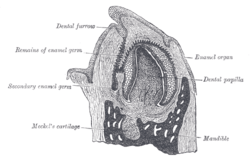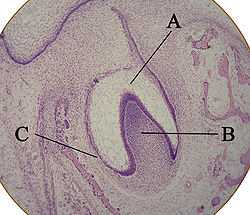Dental papilla
| Dental papilla | |
|---|---|
 Vertical section of the mandible of an early human fetus. X 25. (Dental papilla labeled at center right.) | |
 Histologic slide showing a tooth bud. A: enamel organ B: dental papilla C: dental follicle | |
| Details | |
| Latin | papilla dentis |
| Identifiers | |
| Gray's | p.1122 |
| MeSH | A14.549.167.900.720.250 |
| Code | TE E04.0.3.3.1.0.12 |
| TA | A05.1.03.054 |
| FMA | 57662 |
| Anatomical terminology | |
The dental papilla is a condensation of ectomesenchymal cells called odontoblasts, seen in histologic sections of a developing tooth. It lies below a cellular aggregation known as the enamel organ. The dental papilla appears after 8-10 weeks intra uteral life. The dental papilla gives rise to the dentin and pulp of a tooth.
The enamel organ, dental papilla, and dental follicle together forms one unit, called the tooth germ. This is of importance because all the tissues of a tooth and its supporting structures form from these distinct cellular aggregations.
See also
- Tooth development proceeds into three stages: the bud, cap and bell stage. these terms are descriptive of the morphology of the developing tooth germ but do not describe the significant functional changes that occur during development, such as morphogenesis and histodifferentiation.
References
- Cate, A.R. Ten. Oral Histology: development, structure, and function. 5th ed. 1998. ISBN 0-8151-2952-1.
External links
- Dental+papilla at eMedicine Dictionary
| ||||||||||||||||||||||||||||||||||||||||||||||||||||||||||||||||||||||||||
| ||||||||||||||||||||||||||||||||||||||||||||||